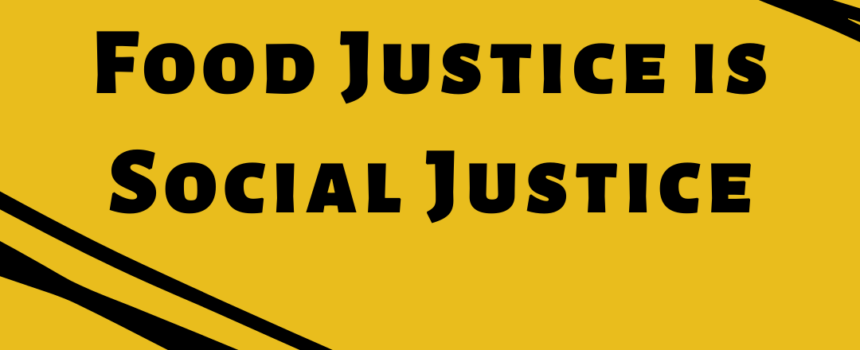Written by Sabrina Hoenig, Content Manager Intern
A key part of Each Green Corners mission is to confront the widespread issue of food insecurity in the Bay Area through community organizing that inspires collective action to create a food network that increases access to healthy, fresh, and culturally diverse produce. The EGC model of community work relies on assessing the needs of the communities we seek to support and bringing in and amplifying voices in those communities to create sustainable food networks that can reproduce themselves and empower members of the community to be part of and lead the process. While all of this work is critical, particularly at this moment, to the future of our food systems (Grogan, 2021), it is also critical to acknowledge and unpack the structural reasons for the pervasive reality of food insecurity in this country.
Food insecurity is an experience that individuals face when they live in a place without access to affordable, healthy, and fresh foods and it is experienced compounded for individuals with multiple intersectional (historically and ongoingly oppressed) identities. Bowen and colleagues assert “that to truly address food insecurity it is necessary to adopt a wider perspective looking at how experiences of food insecurity are not just tied to allocation of material resources, but rooted in racism” (Bowen et al., 2019). So where the food justice movement asserts that access to healthy, fresh food is a basic human right, access must be equitably distributed because food injustices disproportionately harm communities of color. According to research by Morales et al., race is a dominating predictor for an individual’s food security. They noted that despite intersections of racial identity and socioeconomic background, when social and economic factors are controlled, race and racism still explain the higher risk of food insecurity for people of color (Morales et al., 2021). Therefore, part of food justice is to amend the harm of this country’s food systems that disproportionately harms communities of color. The food justice movement is inextricably linked to the racial justice movement because of “our current food system is a legacy [and ongoing reality] of exploitation and racism” (Dombalis, 2022).

For decades, particular racial demographics including Black, Latinx, and Indigenous peoples, were described as living in food deserts, a term that assumes these communities are naturally barren and unable to produce food (Sevilla, 2021). This term obscures the vitality and community networks that exist in actual deserts but also exist in current day [outsider] described food deserts. The use of the term “food desert” does not create space to explain the racially discriminatory policies that brought about limited access to healthy food but instead positions the blame of these circumstances onto the people in these communities. A more appropriate term to explain the racially disparate experience of food insecurity is “food apartheid.” This phrase provides a nuanced explanation into the ways polices such as zoning codes, mortgage lending practices, disinvestment and other racially discriminatory housing and economic practices shape the landscape of communities and predetermine public health outcomes for members of the community. Thus, the concept of “food apartheid” acknowledges the ways race plays into social relations and has created a food system largely built on the labor and disadvantagement of people of color. This acknowledgment of the way many communities are structured in relation to food access is critical to beginning the process of healing and moving towards an equitable food system.
Racial Justice is “a vision and transformation of society to eliminate racial hierarchies and advance collective liberation, where Black, Indigenous, Latinx, Asian Americans, Native Hawaiians, and Pacific Islanders, in particular, have the dignity, resources, power, and self-determination to fully thrive” (Race Forward). Moving towards this transformation requires employing racial equity practices which are the measurable steps that begin to change policies, practices, and systems. Racial equity work within EGC’s work is employing otherwise unused spaces and transforming those spaces into gardens and orchards that will continue to provide, communing with members of the community, accessing needs, and requesting feedback, keeping EGC’s mission close to bridge the gap in land productivity and food access and distribution, and engaging with radical community work to push each other to be and do better. Taking on a racial justice framework in our food justice work is essential and can have a transformative effect on all communities because supporting those who are most marginalized has an upward effect and improves the livelihood of everyone.
Resources:
Advocate for Food Equity & Justice – Dutchess Outreach. Dutchess Outreach. (2022). Retrieved 11 February 2022, from https://dutchessoutreach.org/advocate-food-justice/.
Bowen, S., Elliott, S., & Hardison‐Moody, A. (2021). The structural roots of food insecurity: How racism is a fundamental cause of food insecurity. Sociology Compass, 15(7). https://doi.org/10.1111/soc4.12846
Dombalis, H. (2022). There Is No Food Justice Without Racial Justice. Farmtoschool.org. Retrieved 11 February 2022, from https://www.farmtoschool.org/news-and-articles/there-is-no-food-justice-without-racial-justice.
Grogan, N. (2022). What Are Food Systems?. Eachgreencorner.org. Retrieved 11 February 2022, from https://www.eachgreencorner.org/2021/07/20/what-are-food-systems/.
Food Justice is Social Justice: Advocating for Racial and Social Justice – Greater Pittsburgh Community Food Bank. Greater Pittsburgh Community Food Bank. (2022). Retrieved 11 February 2022, from https://pittsburghfoodbank.org/2020/07/26/food-justice-social-justice-advocating-racial-social-justice/.
Morales, D. X., Morales, S. A., & Beltran, T. F. (2021). Racial/Ethnic Disparities in Household Food Insecurity During the COVID-19 Pandemic: a Nationally Representative Study. Journal of racial and ethnic health disparities, 8(5), 1300–1314. https://doi.org/10.1007/s40615-020-00892-7
Racial Justice in Education: Key Terms and Definitions | NEA. Nea.org. (2022). Retrieved 11 February 2022, from https://www.nea.org/professional-excellence/student-engagement/tools-tips/racial-justice-education-key-terms-and.
Sevilla, N. (2022). Food Apartheid: Racialized Access to Healthy Affordable Food. NRDC. Retrieved 11 February 2022, from https://www.nrdc.org/experts/nina-sevilla/food-apartheid-racialized-access-healthy-affordable-food.
Tanner, Z. (2022). Food Systems for the Future: Envisioning Urban Agriculture in the Fight for Food Justice. Eachgreencorner.org. Retrieved 11 February 2022, from https://www.eachgreencorner.org/2021/02/26/food-systems-for-the-future-envisioning-urban-agriculture-in-the-fight-for-food-justice/.
What Is Food Insecurity in America? | Hunger and Health. Hunger and Health. (2022). Retrieved 11 February 2022, from https://hungerandhealth.feedingamerica.org/understand-food-insecurity/.
What is Racial Equity?. Race Forward. (2022). Retrieved 11 February 2022, from https://www.raceforward.org/about/what-is-racial-equity-key-concepts.


0 Comments